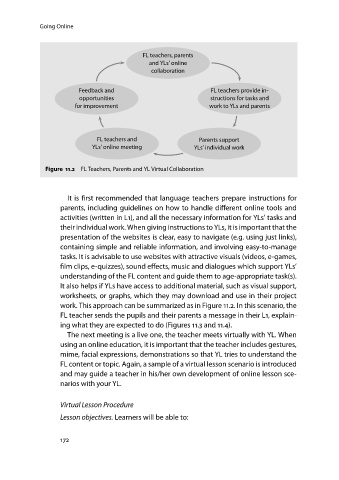Page 172 - Teaching English at Primary Level: From Theory into the Classroom
P. 172
Going Online
FL teachers, parents
and YLs’ online
collaboration
Feedback and FL teachers provide in-
opportunities structions for tasks and
for improvement work to YLs and parents
FL teachers and Parents support
YLs’ online meeting YLs’ individual work
Figure 11.2 FL Teachers, Parents and YL Virtual Collaboration
It is first recommended that language teachers prepare instructions for
parents, including guidelines on how to handle different online tools and
activities (written in L1), and all the necessary information for YLs’ tasks and
their individual work. When giving instructions to YLs, it is important that the
presentation of the websites is clear, easy to navigate (e.g. using just links),
containing simple and reliable information, and involving easy-to-manage
tasks. It is advisable to use websites with attractive visuals (videos, e-games,
film clips, e-quizzes), sound effects, music and dialogues which support YLs’
understanding of the FL content and guide them to age-appropriate task(s).
It also helps if YLs have access to additional material, such as visual support,
worksheets, or graphs, which they may download and use in their project
work. This approach can be summarized as in Figure 11.2. In this scenario, the
FL teacher sends the pupils and their parents a message in their L1, explain-
ing what they are expected to do (Figures 11.3 and 11.4).
The next meeting is a live one, the teacher meets virtually with YL. When
using an online education, it is important that the teacher includes gestures,
mime, facial expressions, demonstrations so that YL tries to understand the
FL content or topic. Again, a sample of a virtual lesson scenario is introduced
and may guide a teacher in his/her own development of online lesson sce-
narios with your YL.
Virtual Lesson Procedure
Lesson objectives. Learners will be able to:
172

